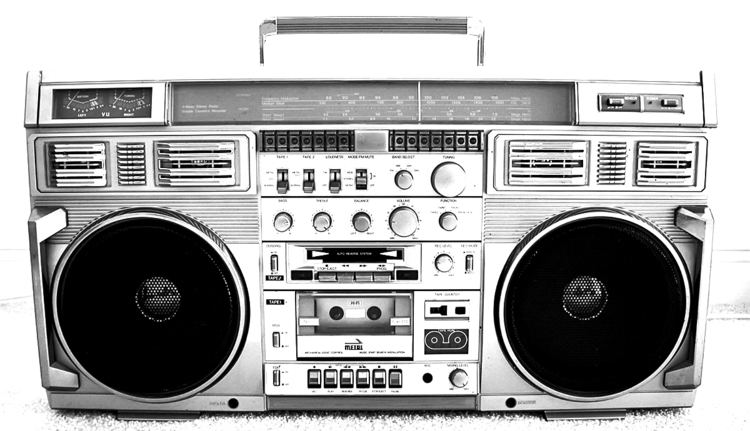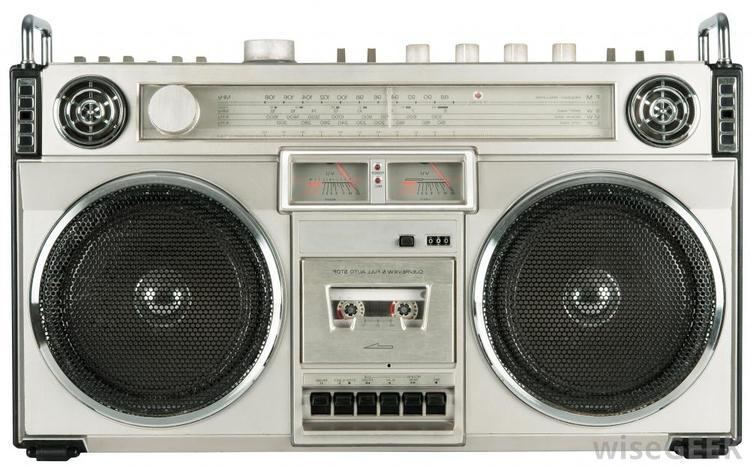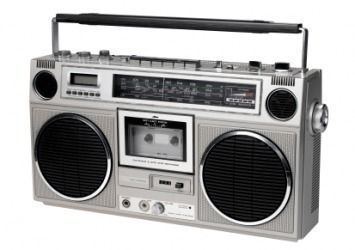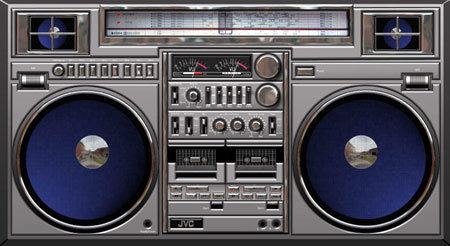 | ||
Boombox is a common term for a portable transistorized cassette tape recorder/player and AM/FM radio (and, beginning in the 1980s, a CD player) with an amplifier, two or more loudspeakers and a carrying handle. A boombox is a device typically capable of receiving radio stations and playing recorded music (usually cassettes or CDs usually at a high volume). Many models are also capable of recording onto cassette tapes from radio and other sources. Designed for portability, boomboxes can be powered by batteries as well as by line current. The boombox was introduced to the American market during the mid-1970s. The desire for louder and heavier bass led to bigger and heavier boxes; by the 1980s, some boomboxes had reached the size of a suitcase. Most boomboxes were battery-operated, leading to extremely heavy, bulky boxes, some times explosive.
Contents
- Boombox ft julian casablancas
- History
- Design
- Cultural significance
- Music
- Films
- Other appearances
- Decline
- Compressed digital audio and the future of boomboxes
- References

The boombox quickly became associated with urban society in the United States, particularly African American and Hispanic youth. The wide use of boomboxes in urban communities led to the boombox being coined a "ghetto blaster", a pejorative nickname which was soon used as part of a backlash against the boombox and hip hop culture. Cities petitioned for the banning of boomboxes from public places, and they became less acceptable on city streets as time progressed. The boombox became closely linked to American hip hop culture and was instrumental in the rise of hip hop music.

Boombox ft julian casablancas
History

The first boombox was developed by the inventor of the audio compact cassette, Philips of the Netherlands. Their first 'Radiorecorder' was released in 1966. The Philips innovation was the first time that radio broadcasts could be recorded onto cassette tapes without the cables or microphones that previous stand-alone cassette tape recorders required. Although sound quality of early tape recordings was poor, improvements in technology and the introduction of stereo recording, chromium tapes, and noise reduction made hifi quality devices possible. Several European electronics brands, such as Grundig, also introduced similar devices.

Boomboxes were soon also developed in Japan in the early 1970s and became popular there due to their compact size and impressive sound quality. The Japanese brands soon took over a large portion of the European boombox market and were often the first Japanese consumer electronics brands that a European household might purchase. The Japanese innovated by creating different sizes, form factors, and technology, introducing such advances as stereo boomboxes, removable speakers, in-built TV receivers, and inbuilt CD players.

The boombox was introduced to the American market during the mid-1970s, with the bulk of production being carried out by Panasonic, Sony, Marantz, and General Electric. It was immediately noticed by the urban adolescent community and soon had a large market, especially in metropolitan centers such as New York, Los Angeles, and Washington D.C.

The earlier models were a hybrid that combined the booming sound of large in-home stereo systems and the portability of small portable cassette players; they were typically small, black or silver, heavy, and capable of producing high volumes. The effective AM/FM tuner, standard in all early boomboxes, was the most popular feature of the early boombox up until the incorporation of input and output jacks into the boxes, which allowed for the coupling of devices such as microphones and turntables.
The development of audio jacks brought the boombox to the height of its popularity, and as its popularity rose, so did the level of innovation in the features included in the box. Consumers enjoyed the portability and sound quality of boomboxes, but one of the most important features, especially to the youth market, was the bass. The desire for louder and heavier bass led to bigger and heavier boxes.
Regardless of the increasing weight and size, the devices continued to become larger to accommodate the increased bass output; newer boombox models were affixed with heavy metal casings to handle the vibrations from the bass.
Design
A boombox, in its most basic form, is composed of two or more loudspeakers, an amplifier, a radio tuner, and a cassette or CD player component, all housed in a single plastic or metal case with a handle for portability. Most units can be powered by AC or DC cables in addition to batteries.
As boomboxes grew in popularity, they also became more complex in design and functionality. By the late 1980s, many boomboxes included separate high and low frequency speakers and a second tape deck to allow the boombox to record off of both the radio and other pre-recorded cassettes. Equalizers, balance adjusters, Dolby noise reduction, and LED sound gauges were other later additions.
In the mid-1980s, the boombox began to become a status symbol; the popularity among young urbanites caused increasing demand for extravagant boxes. The introduction of the compact disc (CD) in the early 1990s led to the introduction of the CD player in standard boombox design. As the 1990s continued, boombox manufacturers began designing smaller, more compact boomboxes, which were often made out of plastic instead of metal as their counterparts from the previous decade had been.
The rectangular, angular, chrome aesthetic of many 1980s models was frequently replaced with black plastic in the 1990s, and modern designs are typically characterized by curves instead of right angles. However, the designs of older models are a source of much interest among enthusiasts and collectors, who frequently seek the larger feature-packed models. Most modern boomboxes come with iPod docks to access MP3 technology (in place of cassette players), and some even come equipped with integrated or removable satellite radio tuners.
Boombox designs vary greatly in size. Larger, more powerful units may require 10 or more size-D batteries, may measure more than 760 millimetres (30 in) in width, and can weigh more than 12 kilograms (26 lb). Some take a 12-volt sealed lead-acid battery, or can be a portable enclosure for a car audio head unit.
Audio quality and feature sets vary widely, with high-end models providing features and sound comparable to some home stereo systems. Most models offer volume, tone and balance (left/right) controls.
Most brands were manufactured in Japan by companies such as Aiwa, Sanyo, Hitachi, JVC, Panasonic, Sharp, Sony, and Toshiba. Also, boomboxes from some European brands were available, like Philips or Grundig. In east Europe there were also manufactured some boomboxes, notably in the Soviet Union (like Vega, Oreanda or VEF) East Germany ( by RFT), Hungary ( Orion and Videoton), Romania (the Stereo Spatial RC). However their quality was lower, however some of them were exported in the west as budget, discount or low cost products.
More sophisticated models may feature dual cassette decks (often featuring high-speed dubbing, or sometimes even digitally controlled servo cassette mechanics), separate bass and treble level controls, five- or ten-band graphic equalizers, Dolby noise reduction, analog or LED sound level (VU) meters or even VFD, larger speakers, 'soft-touch' tape deck controls, multiple shortwave (SW) band reception with fine tuning, digital tuner with PLL, automatic song search functions for cassettes, line and/or phono inputs and outputs, microphone inputs, loudness switches, and detachable speakers, full function infrared remote control. A handful of models even featured an integrated vinyl record player, an 8-track tape player or a (typically black-and-white) television screen, although the basic radio/cassette models have historically been by far the most popular.
Cultural significance
The boombox quickly became associated with urban society, particularly Black and Hispanic youth. The wide use of boomboxes in urban communities led to the boombox being coined a "ghetto blaster", a nickname which was soon used as part of a backlash against the boombox and hip hop culture. Cities began banning boomboxes from public places, and they became less acceptable on city streets as time progressed.
The boombox became intrinsically linked to hip hop culture and, as Fab Five Freddy puts it, was "instrumental" in the rise of hip hop. Certain models like the JVC RC-M90 and the Sharp GF-777 were known as the boombox kings, having the power to drown out other ghetto blasters; they were frequently used in music battles. The Beastie Boys embraced the boombox as a signature, The Clash always had a boombox with them, and Schoolly D carried around a Conion 100cf in the UK.
Music
Films
Other appearances
Decline
The 1990s were a turning point for the boombox in popular culture. The rise of the Walkman and other advanced electronics eliminated the need to carry around such large and heavy audio equipment, and boomboxes quickly disappeared from the streets. As boombox enthusiast Lyle Owerko puts it, "Towards the end of any culture, you have the second or third generation that steps into the culture, which is so far from the origination, it's the impression of what's real, but it's not the full definition of what's real. It's just cheesy." The Consumer Electronics Association reported that only 329,000 boombox units without CD players were shipped in the United States in 2003, compared to 20.4 million in 1986.
Compressed digital audio and the future of boomboxes
Although many boomboxes had dual cassette decks and included dubbing, line, and radio recording capabilities, the rise of recordable CDs, the decline of audio cassette technology, and the popularity of high-density MP3 players and smart phones have reduced the popularity of high-quality boomboxes to such an extent that it is difficult to find a new dual-decked stereo. Dubbing remains popular among audiophiles, bootleggers, and pirates, though most tasks are now accomplished through digital means or analog-to-digital conversion technology.
Most modern boomboxes include a CD player compatible with CD-R and CD-RW, which allows the user to carry their own music compilations on a higher fidelity medium. Many also permit iPod and similar devices to be plugged into them through one or more auxiliary ports. Some also support formats such as MP3 and WMA.
The simplest way to connect an older boombox to an MP3 player is to use a cassette adapter, which interfaces an MP3 player's output directly to the cassette player's heads. The 'Line In' (also known as 'Aux In') can be used if the boombox has one.
Some modern boombox designs provide other connections for MP3 (and sometimes other digital formats) such as a USB connector for use with a removable USB drive, slots for various flash memory media such as SD, MMC, SmartMedia, and Memory Stick, or even a CD drive capable of reading MP3s directly from a CD, thus allowing for a relatively cheap and large music storage to be carried and played back at full volume.
Starting in mid-2010, there are new lines of boomboxes that use Bluetooth technology known as Stereo Bluetooth, or A2DP (Advanced Audio Distribution Profile). They use the wireless Bluetooth technology to "stream" audio to the boombox from a compatible Bluetooth device, such as a mobile phone or Bluetooth MP3 player. An example of this is the JAMBOX, which is marketed as a "Smart Speaker" as it can also function as a speakerphone for voice calls in addition to being an audio playback device.
Another modern variant is a DVD player/boombox with a top-loading CD/DVD drive and an LCD video screen in the position once occupied by a cassette deck. Many models of this type of boombox include inputs for external video (such as television broadcasts) and outputs to connect the DVD player to a full-sized television.
